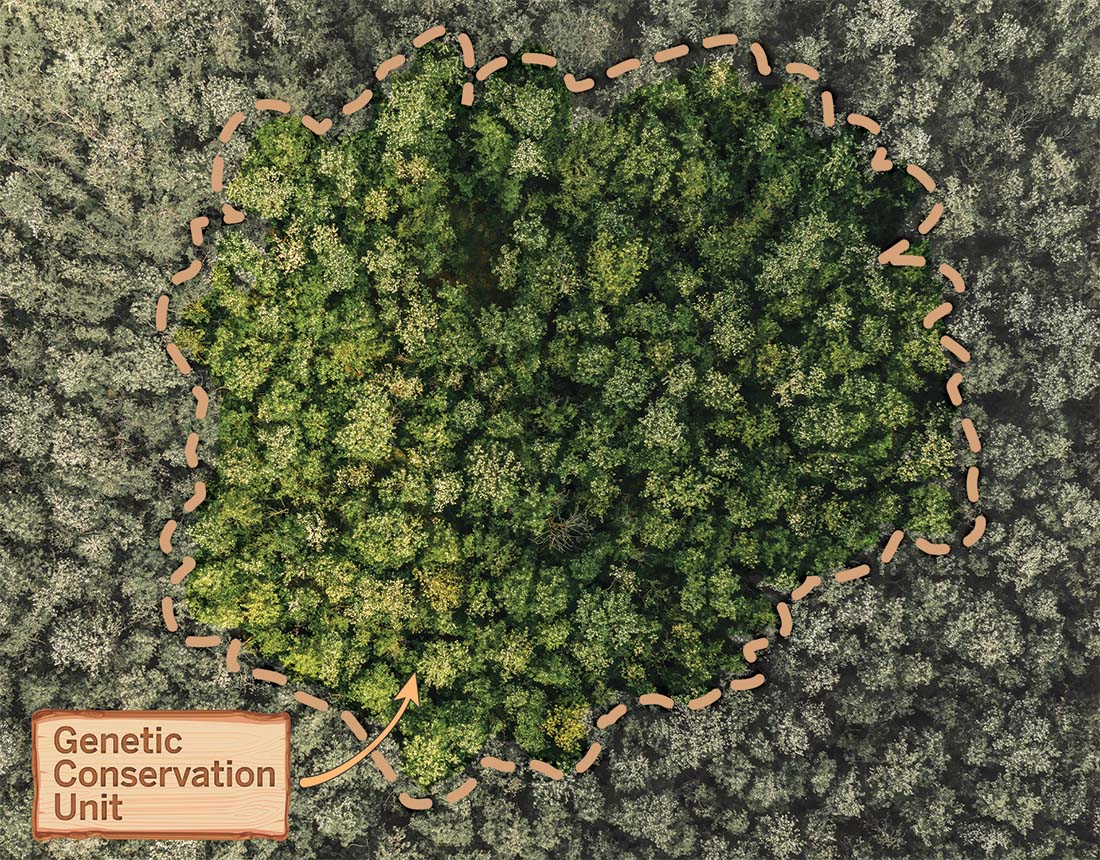What is a Genetic Conservation Unit?
A Genetic Conservation Unit (GCU) is a forest area that is formally designated to the protection of forest genetic resources (FGR) of one or more forest tree species. It is established to allow the full cycle of natural processes to occur with the conservation objective of dynamically conserving the evolutionary potential of the population

Where are GCU located?
GCUs are typically located in forests managed for multiple uses, protected areas or seed stands. They can support the genetic conservation of the designated forest tree species population in two different ways:
- in situ: at the site where the tree population is native.
- ex situ: in another location.
The GCU Network
European countries are coordinating their efforts to proactively conserve invaluable FGR through the European Forest Genetic Resources Programme (EUFORGEN), as part of a Pan-European effort for a joint conservation strategy. EUFORGEN fosters this conservation through a network of Genetic Conservation Units (GCU) across Europe. A selection of GCUs of a given species, form the GCU core network of the species.
GCU minimum requirements
Each site should meet a set of minimum requirements to be recognised as a Genetic Conservation Unit.
The purpose of the minimum requirements is to define what ‘a dynamic genetic conservation unit’ is and increase awareness of how such units should be managed so that they contribute long-term genetic conservation, i.e. maintenance of evolutionary processes within tree populations.
- Designation: The units should have a designated status as genetic conservation areas of forest trees at national level. The units can be located in forests managed for multiple uses, protected areas or seed stands.
- Minimum size: The minimum size of a unit depends on tree species and conservation objectives as follows; 1) 500 or more reproducing trees (when the objective is to conserve genetic diversity of widely occurring and stand-forming conifers or broadleaf species), 2) 50 reproducing trees (when the objective is to conserve adaptive or other traits in marginal or scattered tree populations) or 50 seed bearing trees (scattered tree species with sexual dimorphism), and 3) 15 unrelated reproducing trees (when the objective is to conserve remaining populations of rare or endangered tree species).
- Target species: One or more tree species should be recognized as target tree species for each unit. This means that the management efforts for the purpose of genetic conservation are being carried out to equally favour these species. If a unit has several target species, each target species must meet the appropriate minimum population size, as indicated above.
- Management: The management of the units should aim to maintain and enhance the long-term evolutionary potential of tree populations. This means that management measures and silvicultural techniques are applied, as needed, to favour genetic processes that maintain the long-term viability of target tree populations.
- Monitoring: The monitoring of the units should be carried out by visiting them regularly to observe that they still serve their purpose and that they have not been damaged or destroyed. A comprehensive assessment of the units should ideally be carried out through systematic field inventories conducted every 5 or 10 years.
You can read the minimum requirements in detail here.
EUFGIS: GCU data at your fingertips
Information on GCUs is entered by a network of National Focal Points into the European Information System on Forest Genetic Resources (EUFGIS). EUFGIS is a unique system which enables countries’ reporting in a harmonised and reliable manner. It supports the identification of gaps in conservation of forest species at European level and the setting of priorities to fill these conservation gaps.
GCUs stored in EUFGIS are characterised using remote sensing and existing climatic datasets, and other information on FGR, such as genetic and phenotypic indicators. This means that valuable information on forest tree species is readily available and easily accessible to forest managers. EUFGIS is managed and maintained by EUFORGEN.


